Healthcare Operations Report: GMH Problems and Solutions Analysis
VerifiedAdded on 2021/02/20
|10
|3131
|51
Report
AI Summary
This report analyzes the healthcare operations at Greater Matonga Hospital (GMH), a major hospital in Melbourne, Australia. It identifies key problems, including ineffective communication, inadequate staffing, and patient enrollment delays. The report applies Weber's classical organizational theory and Herzberg's motivational theory to propose solutions. It emphasizes the importance of effective communication, clear roles, and responsibilities, as well as the implementation of motivational strategies to improve staff retention and patient satisfaction. The report also discusses the role of BPR, recruitment, and training programs in enhancing service delivery and addressing the shortage of general practitioners in the polyclinic. It suggests improvements to the appointment system and highlights the significance of providing a supportive working environment, competitive pay, and opportunities for professional growth to motivate employees and achieve organizational goals.
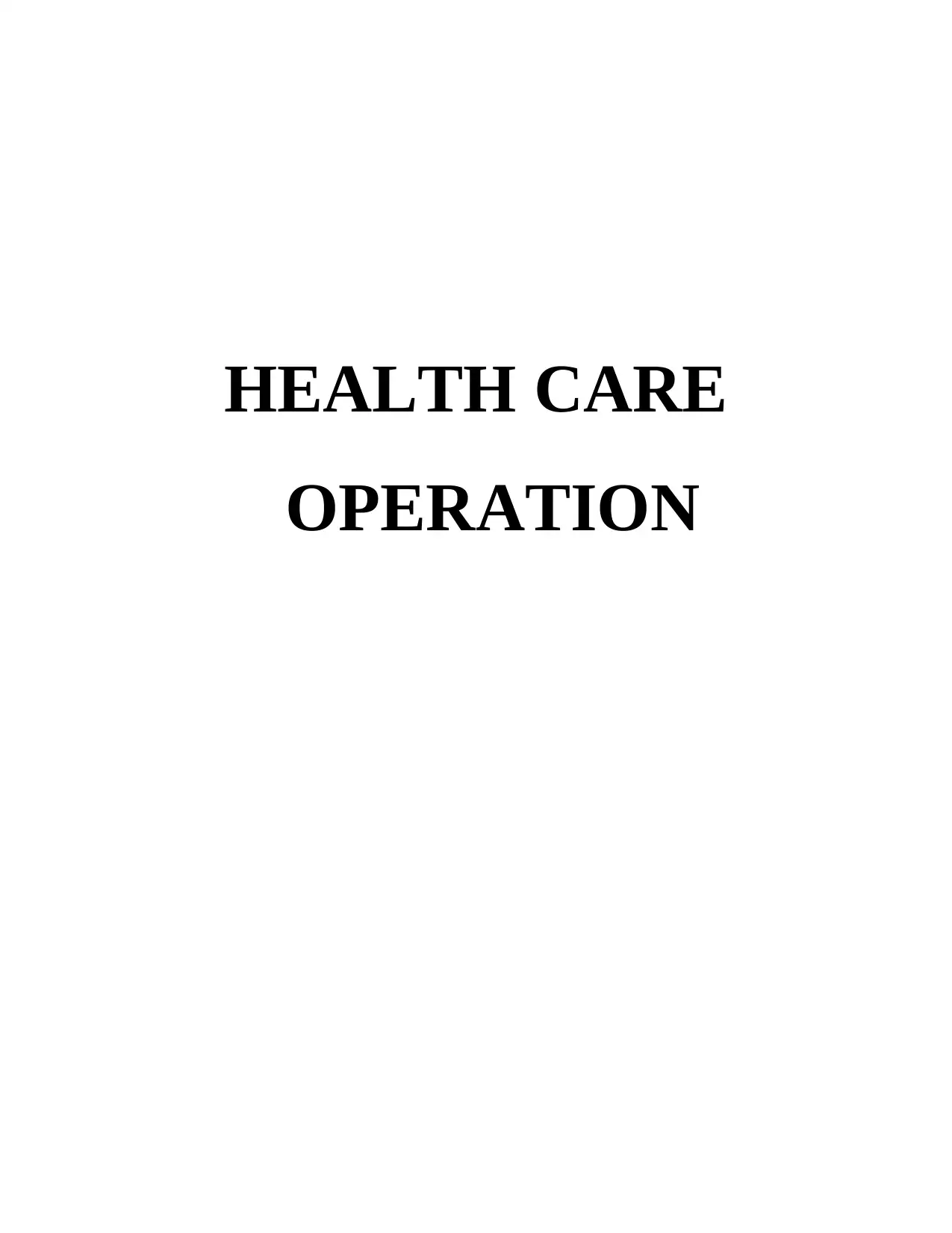
HEALTH CARE
OPERATION
OPERATION
Paraphrase This Document
Need a fresh take? Get an instant paraphrase of this document with our AI Paraphraser
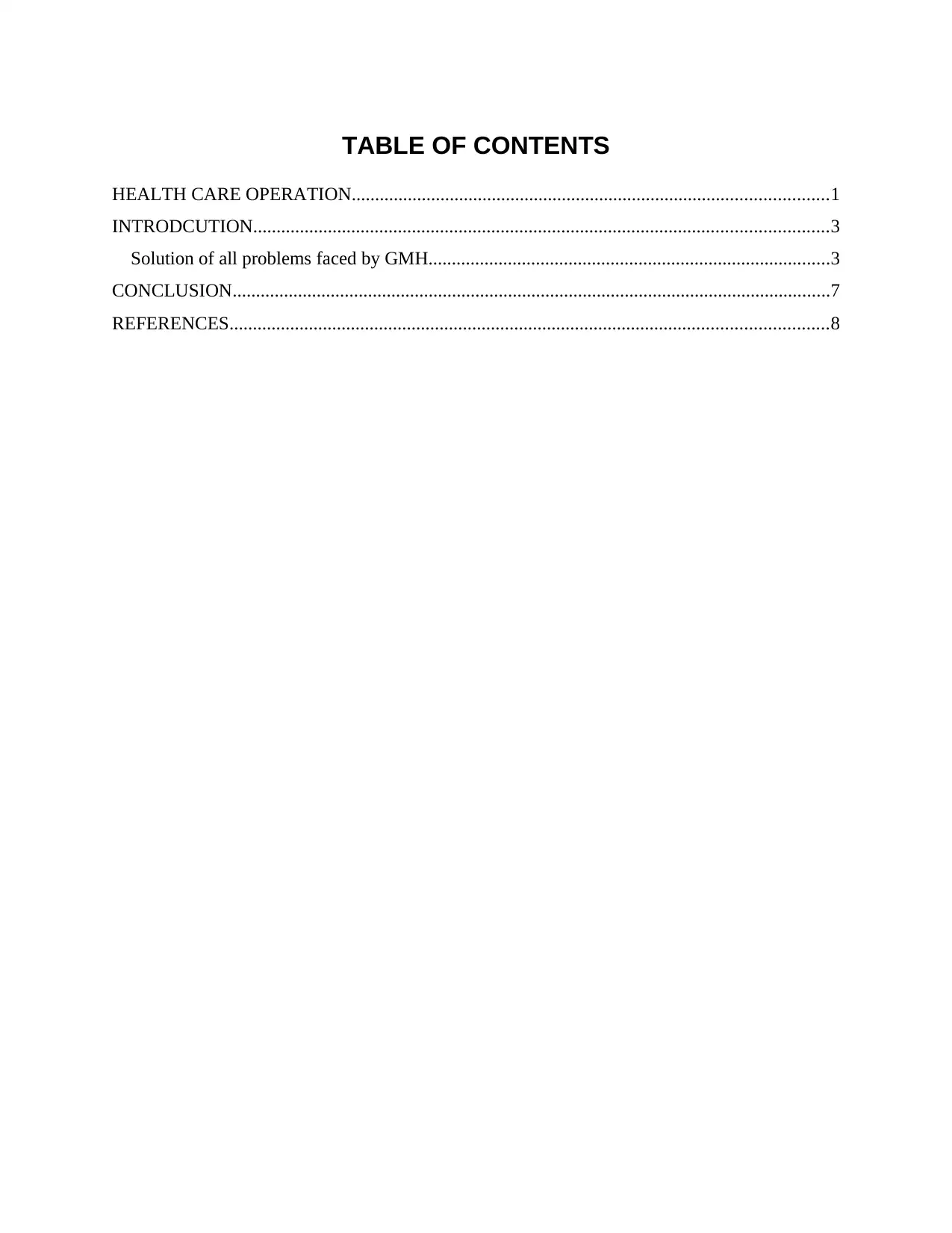
TABLE OF CONTENTS
HEALTH CARE OPERATION......................................................................................................1
INTRODCUTION...........................................................................................................................3
Solution of all problems faced by GMH......................................................................................3
CONCLUSION................................................................................................................................7
REFERENCES................................................................................................................................8
HEALTH CARE OPERATION......................................................................................................1
INTRODCUTION...........................................................................................................................3
Solution of all problems faced by GMH......................................................................................3
CONCLUSION................................................................................................................................7
REFERENCES................................................................................................................................8
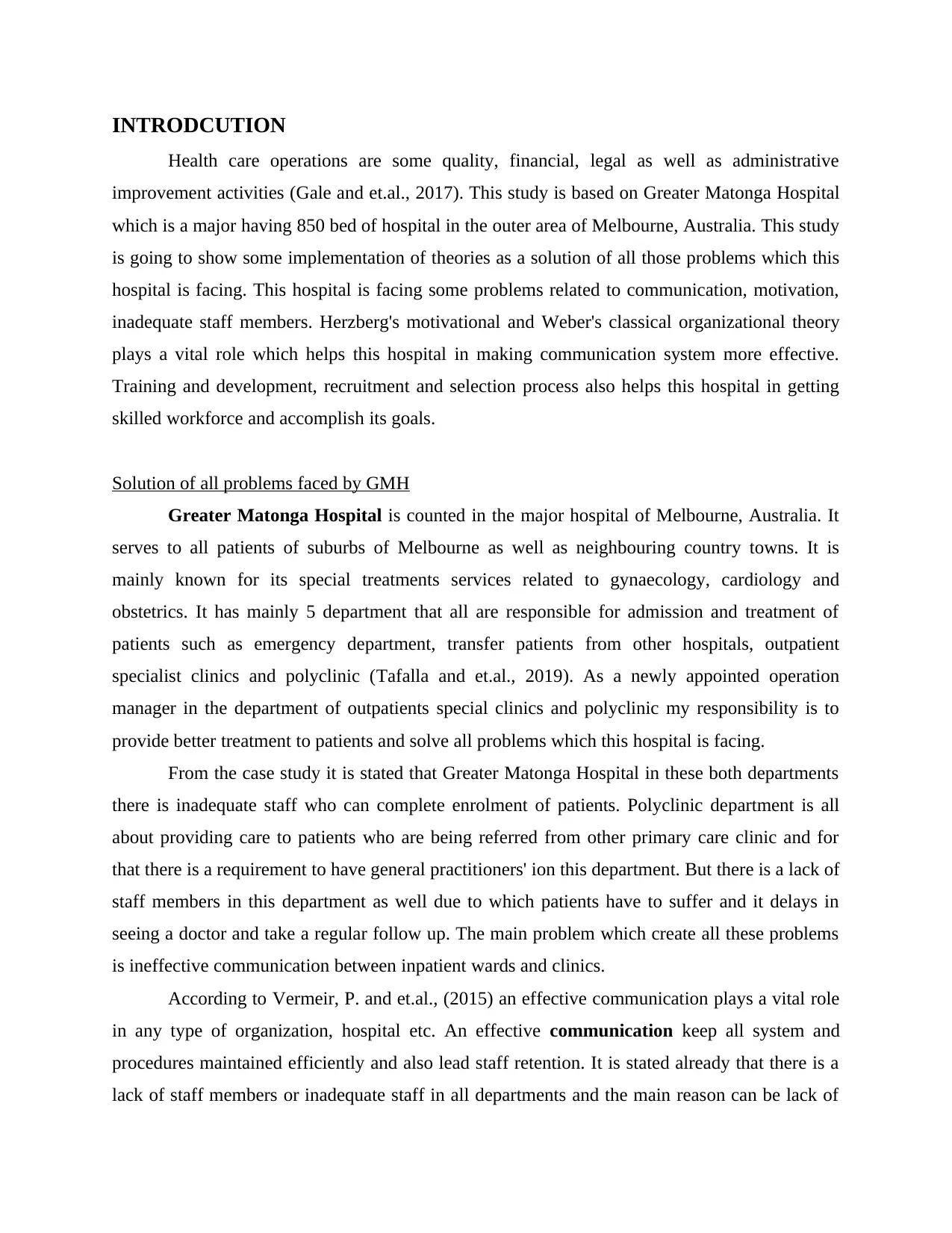
INTRODCUTION
Health care operations are some quality, financial, legal as well as administrative
improvement activities (Gale and et.al., 2017). This study is based on Greater Matonga Hospital
which is a major having 850 bed of hospital in the outer area of Melbourne, Australia. This study
is going to show some implementation of theories as a solution of all those problems which this
hospital is facing. This hospital is facing some problems related to communication, motivation,
inadequate staff members. Herzberg's motivational and Weber's classical organizational theory
plays a vital role which helps this hospital in making communication system more effective.
Training and development, recruitment and selection process also helps this hospital in getting
skilled workforce and accomplish its goals.
Solution of all problems faced by GMH
Greater Matonga Hospital is counted in the major hospital of Melbourne, Australia. It
serves to all patients of suburbs of Melbourne as well as neighbouring country towns. It is
mainly known for its special treatments services related to gynaecology, cardiology and
obstetrics. It has mainly 5 department that all are responsible for admission and treatment of
patients such as emergency department, transfer patients from other hospitals, outpatient
specialist clinics and polyclinic (Tafalla and et.al., 2019). As a newly appointed operation
manager in the department of outpatients special clinics and polyclinic my responsibility is to
provide better treatment to patients and solve all problems which this hospital is facing.
From the case study it is stated that Greater Matonga Hospital in these both departments
there is inadequate staff who can complete enrolment of patients. Polyclinic department is all
about providing care to patients who are being referred from other primary care clinic and for
that there is a requirement to have general practitioners' ion this department. But there is a lack of
staff members in this department as well due to which patients have to suffer and it delays in
seeing a doctor and take a regular follow up. The main problem which create all these problems
is ineffective communication between inpatient wards and clinics.
According to Vermeir, P. and et.al., (2015) an effective communication plays a vital role
in any type of organization, hospital etc. An effective communication keep all system and
procedures maintained efficiently and also lead staff retention. It is stated already that there is a
lack of staff members or inadequate staff in all departments and the main reason can be lack of
Health care operations are some quality, financial, legal as well as administrative
improvement activities (Gale and et.al., 2017). This study is based on Greater Matonga Hospital
which is a major having 850 bed of hospital in the outer area of Melbourne, Australia. This study
is going to show some implementation of theories as a solution of all those problems which this
hospital is facing. This hospital is facing some problems related to communication, motivation,
inadequate staff members. Herzberg's motivational and Weber's classical organizational theory
plays a vital role which helps this hospital in making communication system more effective.
Training and development, recruitment and selection process also helps this hospital in getting
skilled workforce and accomplish its goals.
Solution of all problems faced by GMH
Greater Matonga Hospital is counted in the major hospital of Melbourne, Australia. It
serves to all patients of suburbs of Melbourne as well as neighbouring country towns. It is
mainly known for its special treatments services related to gynaecology, cardiology and
obstetrics. It has mainly 5 department that all are responsible for admission and treatment of
patients such as emergency department, transfer patients from other hospitals, outpatient
specialist clinics and polyclinic (Tafalla and et.al., 2019). As a newly appointed operation
manager in the department of outpatients special clinics and polyclinic my responsibility is to
provide better treatment to patients and solve all problems which this hospital is facing.
From the case study it is stated that Greater Matonga Hospital in these both departments
there is inadequate staff who can complete enrolment of patients. Polyclinic department is all
about providing care to patients who are being referred from other primary care clinic and for
that there is a requirement to have general practitioners' ion this department. But there is a lack of
staff members in this department as well due to which patients have to suffer and it delays in
seeing a doctor and take a regular follow up. The main problem which create all these problems
is ineffective communication between inpatient wards and clinics.
According to Vermeir, P. and et.al., (2015) an effective communication plays a vital role
in any type of organization, hospital etc. An effective communication keep all system and
procedures maintained efficiently and also lead staff retention. It is stated already that there is a
lack of staff members or inadequate staff in all departments and the main reason can be lack of
⊘ This is a preview!⊘
Do you want full access?
Subscribe today to unlock all pages.

Trusted by 1+ million students worldwide
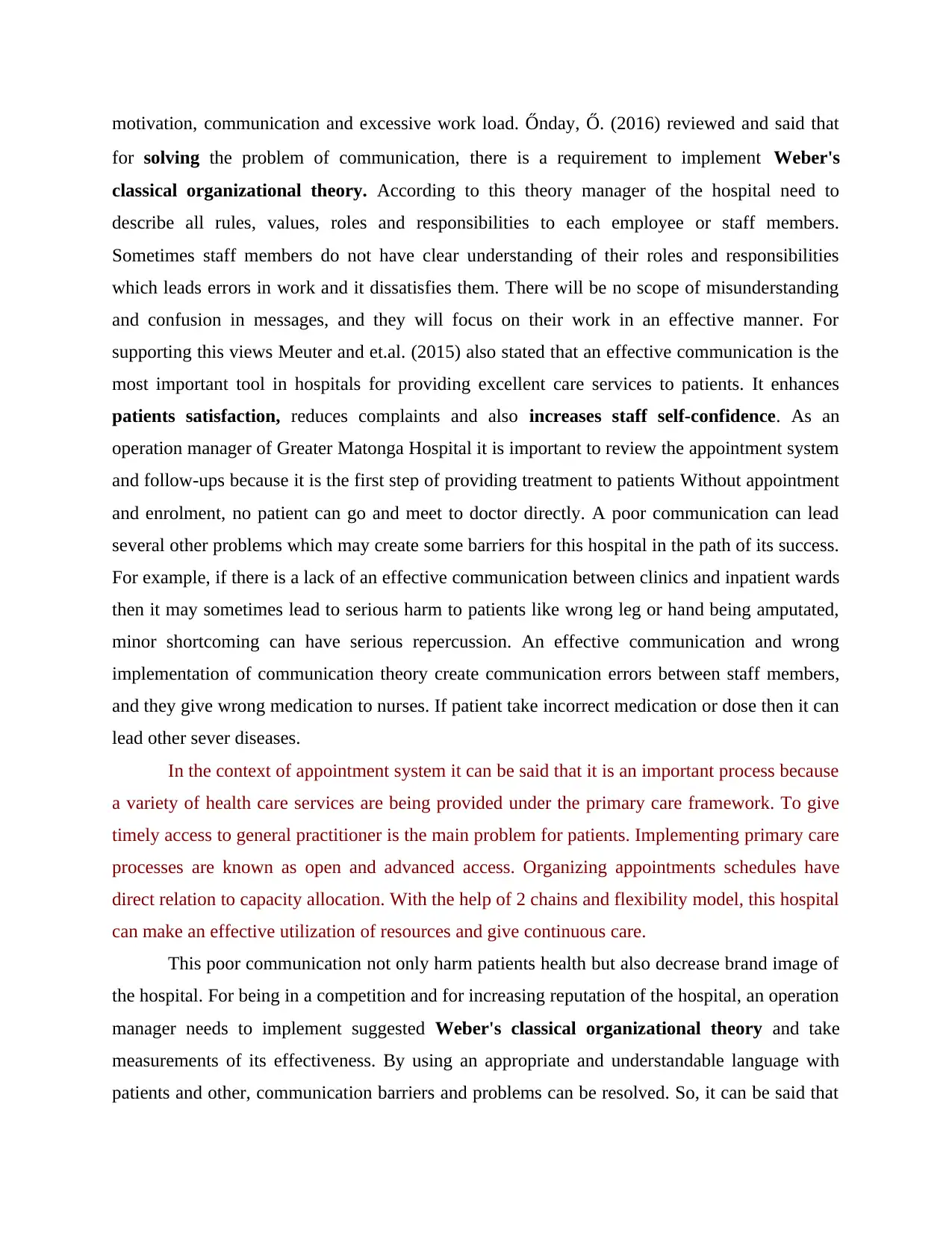
motivation, communication and excessive work load. Őnday, Ő. (2016) reviewed and said that
for solving the problem of communication, there is a requirement to implement Weber's
classical organizational theory. According to this theory manager of the hospital need to
describe all rules, values, roles and responsibilities to each employee or staff members.
Sometimes staff members do not have clear understanding of their roles and responsibilities
which leads errors in work and it dissatisfies them. There will be no scope of misunderstanding
and confusion in messages, and they will focus on their work in an effective manner. For
supporting this views Meuter and et.al. (2015) also stated that an effective communication is the
most important tool in hospitals for providing excellent care services to patients. It enhances
patients satisfaction, reduces complaints and also increases staff self-confidence. As an
operation manager of Greater Matonga Hospital it is important to review the appointment system
and follow-ups because it is the first step of providing treatment to patients Without appointment
and enrolment, no patient can go and meet to doctor directly. A poor communication can lead
several other problems which may create some barriers for this hospital in the path of its success.
For example, if there is a lack of an effective communication between clinics and inpatient wards
then it may sometimes lead to serious harm to patients like wrong leg or hand being amputated,
minor shortcoming can have serious repercussion. An effective communication and wrong
implementation of communication theory create communication errors between staff members,
and they give wrong medication to nurses. If patient take incorrect medication or dose then it can
lead other sever diseases.
In the context of appointment system it can be said that it is an important process because
a variety of health care services are being provided under the primary care framework. To give
timely access to general practitioner is the main problem for patients. Implementing primary care
processes are known as open and advanced access. Organizing appointments schedules have
direct relation to capacity allocation. With the help of 2 chains and flexibility model, this hospital
can make an effective utilization of resources and give continuous care.
This poor communication not only harm patients health but also decrease brand image of
the hospital. For being in a competition and for increasing reputation of the hospital, an operation
manager needs to implement suggested Weber's classical organizational theory and take
measurements of its effectiveness. By using an appropriate and understandable language with
patients and other, communication barriers and problems can be resolved. So, it can be said that
for solving the problem of communication, there is a requirement to implement Weber's
classical organizational theory. According to this theory manager of the hospital need to
describe all rules, values, roles and responsibilities to each employee or staff members.
Sometimes staff members do not have clear understanding of their roles and responsibilities
which leads errors in work and it dissatisfies them. There will be no scope of misunderstanding
and confusion in messages, and they will focus on their work in an effective manner. For
supporting this views Meuter and et.al. (2015) also stated that an effective communication is the
most important tool in hospitals for providing excellent care services to patients. It enhances
patients satisfaction, reduces complaints and also increases staff self-confidence. As an
operation manager of Greater Matonga Hospital it is important to review the appointment system
and follow-ups because it is the first step of providing treatment to patients Without appointment
and enrolment, no patient can go and meet to doctor directly. A poor communication can lead
several other problems which may create some barriers for this hospital in the path of its success.
For example, if there is a lack of an effective communication between clinics and inpatient wards
then it may sometimes lead to serious harm to patients like wrong leg or hand being amputated,
minor shortcoming can have serious repercussion. An effective communication and wrong
implementation of communication theory create communication errors between staff members,
and they give wrong medication to nurses. If patient take incorrect medication or dose then it can
lead other sever diseases.
In the context of appointment system it can be said that it is an important process because
a variety of health care services are being provided under the primary care framework. To give
timely access to general practitioner is the main problem for patients. Implementing primary care
processes are known as open and advanced access. Organizing appointments schedules have
direct relation to capacity allocation. With the help of 2 chains and flexibility model, this hospital
can make an effective utilization of resources and give continuous care.
This poor communication not only harm patients health but also decrease brand image of
the hospital. For being in a competition and for increasing reputation of the hospital, an operation
manager needs to implement suggested Weber's classical organizational theory and take
measurements of its effectiveness. By using an appropriate and understandable language with
patients and other, communication barriers and problems can be resolved. So, it can be said that
Paraphrase This Document
Need a fresh take? Get an instant paraphrase of this document with our AI Paraphraser
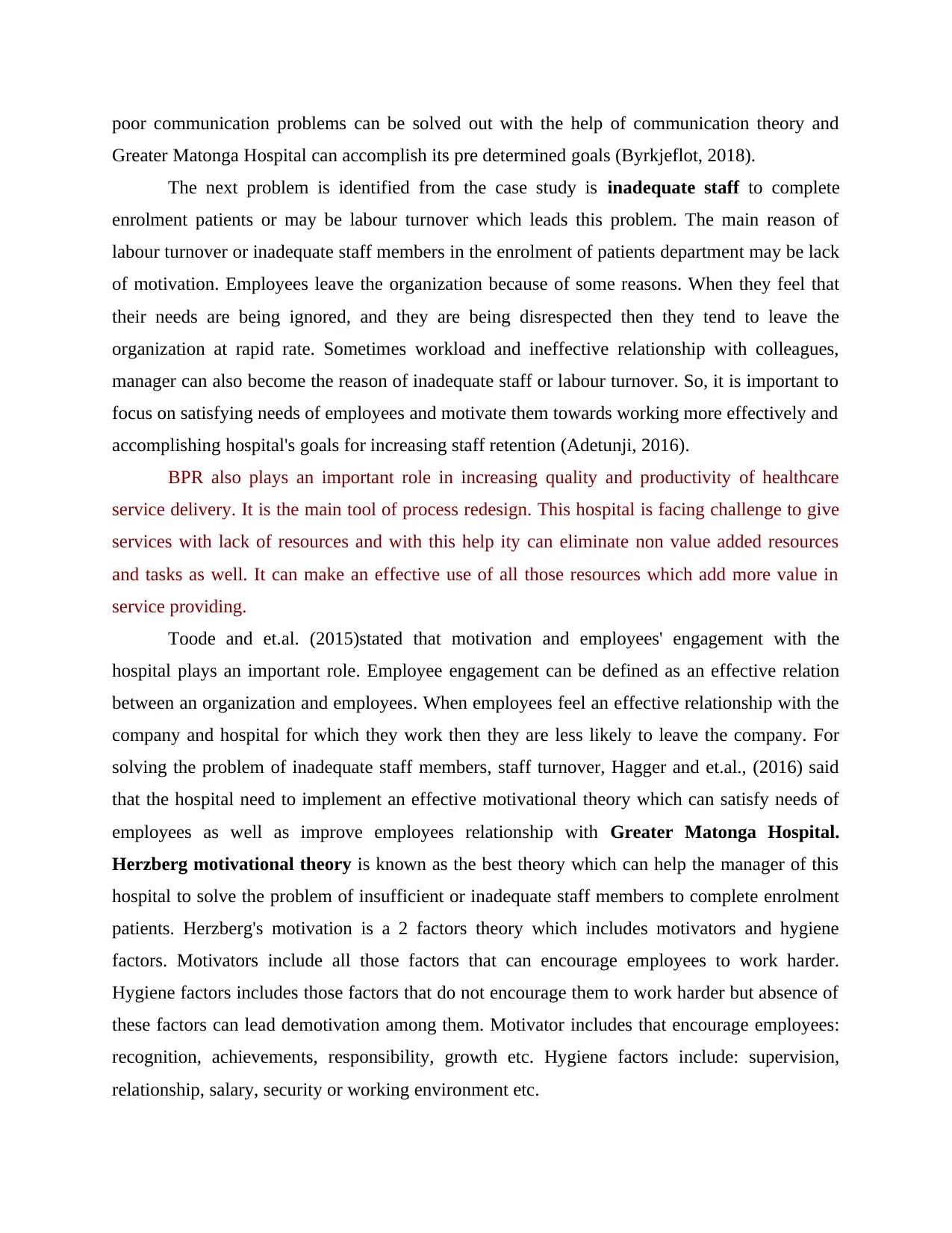
poor communication problems can be solved out with the help of communication theory and
Greater Matonga Hospital can accomplish its pre determined goals (Byrkjeflot, 2018).
The next problem is identified from the case study is inadequate staff to complete
enrolment patients or may be labour turnover which leads this problem. The main reason of
labour turnover or inadequate staff members in the enrolment of patients department may be lack
of motivation. Employees leave the organization because of some reasons. When they feel that
their needs are being ignored, and they are being disrespected then they tend to leave the
organization at rapid rate. Sometimes workload and ineffective relationship with colleagues,
manager can also become the reason of inadequate staff or labour turnover. So, it is important to
focus on satisfying needs of employees and motivate them towards working more effectively and
accomplishing hospital's goals for increasing staff retention (Adetunji, 2016).
BPR also plays an important role in increasing quality and productivity of healthcare
service delivery. It is the main tool of process redesign. This hospital is facing challenge to give
services with lack of resources and with this help ity can eliminate non value added resources
and tasks as well. It can make an effective use of all those resources which add more value in
service providing.
Toode and et.al. (2015)stated that motivation and employees' engagement with the
hospital plays an important role. Employee engagement can be defined as an effective relation
between an organization and employees. When employees feel an effective relationship with the
company and hospital for which they work then they are less likely to leave the company. For
solving the problem of inadequate staff members, staff turnover, Hagger and et.al., (2016) said
that the hospital need to implement an effective motivational theory which can satisfy needs of
employees as well as improve employees relationship with Greater Matonga Hospital.
Herzberg motivational theory is known as the best theory which can help the manager of this
hospital to solve the problem of insufficient or inadequate staff members to complete enrolment
patients. Herzberg's motivation is a 2 factors theory which includes motivators and hygiene
factors. Motivators include all those factors that can encourage employees to work harder.
Hygiene factors includes those factors that do not encourage them to work harder but absence of
these factors can lead demotivation among them. Motivator includes that encourage employees:
recognition, achievements, responsibility, growth etc. Hygiene factors include: supervision,
relationship, salary, security or working environment etc.
Greater Matonga Hospital can accomplish its pre determined goals (Byrkjeflot, 2018).
The next problem is identified from the case study is inadequate staff to complete
enrolment patients or may be labour turnover which leads this problem. The main reason of
labour turnover or inadequate staff members in the enrolment of patients department may be lack
of motivation. Employees leave the organization because of some reasons. When they feel that
their needs are being ignored, and they are being disrespected then they tend to leave the
organization at rapid rate. Sometimes workload and ineffective relationship with colleagues,
manager can also become the reason of inadequate staff or labour turnover. So, it is important to
focus on satisfying needs of employees and motivate them towards working more effectively and
accomplishing hospital's goals for increasing staff retention (Adetunji, 2016).
BPR also plays an important role in increasing quality and productivity of healthcare
service delivery. It is the main tool of process redesign. This hospital is facing challenge to give
services with lack of resources and with this help ity can eliminate non value added resources
and tasks as well. It can make an effective use of all those resources which add more value in
service providing.
Toode and et.al. (2015)stated that motivation and employees' engagement with the
hospital plays an important role. Employee engagement can be defined as an effective relation
between an organization and employees. When employees feel an effective relationship with the
company and hospital for which they work then they are less likely to leave the company. For
solving the problem of inadequate staff members, staff turnover, Hagger and et.al., (2016) said
that the hospital need to implement an effective motivational theory which can satisfy needs of
employees as well as improve employees relationship with Greater Matonga Hospital.
Herzberg motivational theory is known as the best theory which can help the manager of this
hospital to solve the problem of insufficient or inadequate staff members to complete enrolment
patients. Herzberg's motivation is a 2 factors theory which includes motivators and hygiene
factors. Motivators include all those factors that can encourage employees to work harder.
Hygiene factors includes those factors that do not encourage them to work harder but absence of
these factors can lead demotivation among them. Motivator includes that encourage employees:
recognition, achievements, responsibility, growth etc. Hygiene factors include: supervision,
relationship, salary, security or working environment etc.
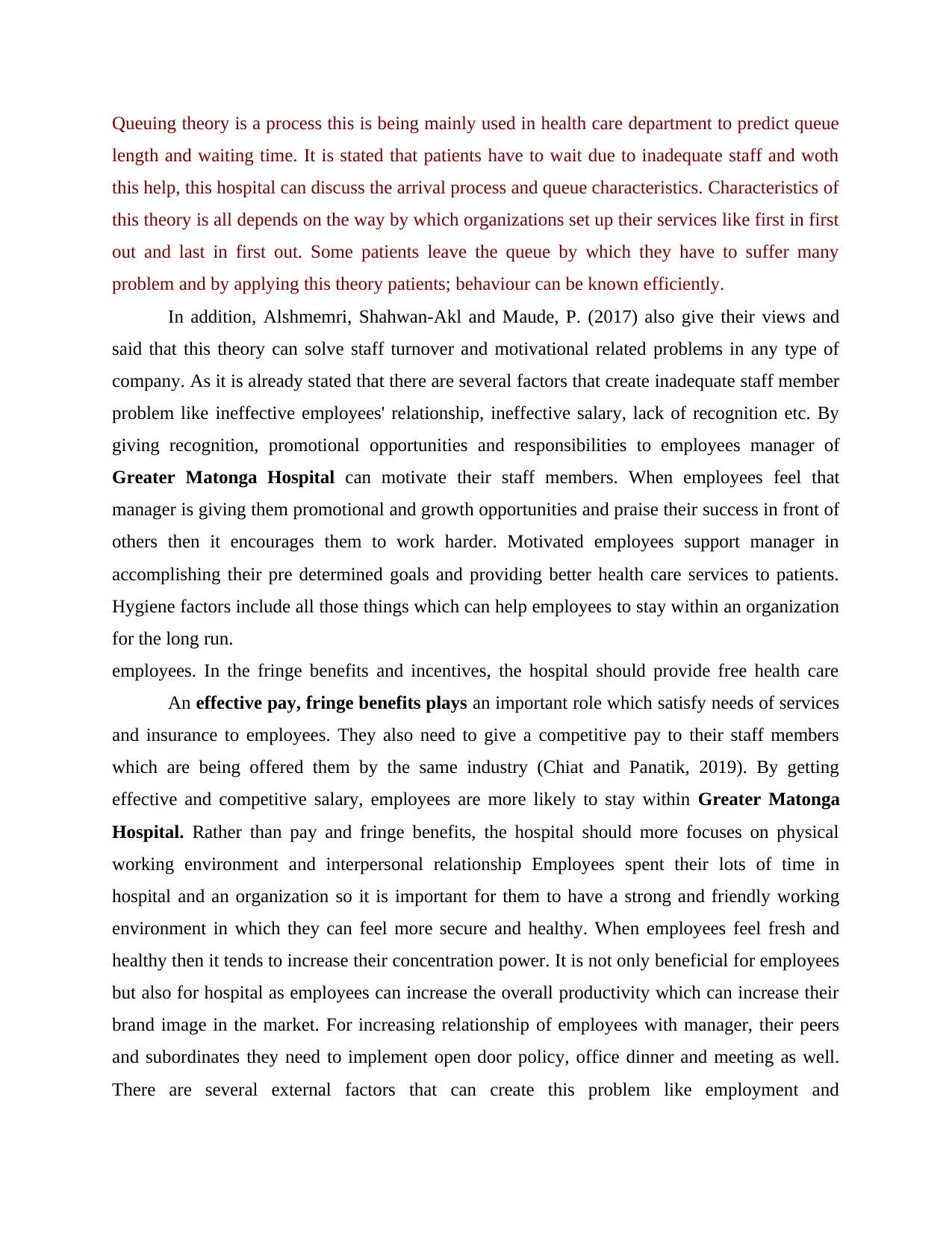
Queuing theory is a process this is being mainly used in health care department to predict queue
length and waiting time. It is stated that patients have to wait due to inadequate staff and woth
this help, this hospital can discuss the arrival process and queue characteristics. Characteristics of
this theory is all depends on the way by which organizations set up their services like first in first
out and last in first out. Some patients leave the queue by which they have to suffer many
problem and by applying this theory patients; behaviour can be known efficiently.
In addition, Alshmemri, Shahwan-Akl and Maude, P. (2017) also give their views and
said that this theory can solve staff turnover and motivational related problems in any type of
company. As it is already stated that there are several factors that create inadequate staff member
problem like ineffective employees' relationship, ineffective salary, lack of recognition etc. By
giving recognition, promotional opportunities and responsibilities to employees manager of
Greater Matonga Hospital can motivate their staff members. When employees feel that
manager is giving them promotional and growth opportunities and praise their success in front of
others then it encourages them to work harder. Motivated employees support manager in
accomplishing their pre determined goals and providing better health care services to patients.
Hygiene factors include all those things which can help employees to stay within an organization
for the long run.
employees. In the fringe benefits and incentives, the hospital should provide free health care
An effective pay, fringe benefits plays an important role which satisfy needs of services
and insurance to employees. They also need to give a competitive pay to their staff members
which are being offered them by the same industry (Chiat and Panatik, 2019). By getting
effective and competitive salary, employees are more likely to stay within Greater Matonga
Hospital. Rather than pay and fringe benefits, the hospital should more focuses on physical
working environment and interpersonal relationship Employees spent their lots of time in
hospital and an organization so it is important for them to have a strong and friendly working
environment in which they can feel more secure and healthy. When employees feel fresh and
healthy then it tends to increase their concentration power. It is not only beneficial for employees
but also for hospital as employees can increase the overall productivity which can increase their
brand image in the market. For increasing relationship of employees with manager, their peers
and subordinates they need to implement open door policy, office dinner and meeting as well.
There are several external factors that can create this problem like employment and
length and waiting time. It is stated that patients have to wait due to inadequate staff and woth
this help, this hospital can discuss the arrival process and queue characteristics. Characteristics of
this theory is all depends on the way by which organizations set up their services like first in first
out and last in first out. Some patients leave the queue by which they have to suffer many
problem and by applying this theory patients; behaviour can be known efficiently.
In addition, Alshmemri, Shahwan-Akl and Maude, P. (2017) also give their views and
said that this theory can solve staff turnover and motivational related problems in any type of
company. As it is already stated that there are several factors that create inadequate staff member
problem like ineffective employees' relationship, ineffective salary, lack of recognition etc. By
giving recognition, promotional opportunities and responsibilities to employees manager of
Greater Matonga Hospital can motivate their staff members. When employees feel that
manager is giving them promotional and growth opportunities and praise their success in front of
others then it encourages them to work harder. Motivated employees support manager in
accomplishing their pre determined goals and providing better health care services to patients.
Hygiene factors include all those things which can help employees to stay within an organization
for the long run.
employees. In the fringe benefits and incentives, the hospital should provide free health care
An effective pay, fringe benefits plays an important role which satisfy needs of services
and insurance to employees. They also need to give a competitive pay to their staff members
which are being offered them by the same industry (Chiat and Panatik, 2019). By getting
effective and competitive salary, employees are more likely to stay within Greater Matonga
Hospital. Rather than pay and fringe benefits, the hospital should more focuses on physical
working environment and interpersonal relationship Employees spent their lots of time in
hospital and an organization so it is important for them to have a strong and friendly working
environment in which they can feel more secure and healthy. When employees feel fresh and
healthy then it tends to increase their concentration power. It is not only beneficial for employees
but also for hospital as employees can increase the overall productivity which can increase their
brand image in the market. For increasing relationship of employees with manager, their peers
and subordinates they need to implement open door policy, office dinner and meeting as well.
There are several external factors that can create this problem like employment and
⊘ This is a preview!⊘
Do you want full access?
Subscribe today to unlock all pages.

Trusted by 1+ million students worldwide
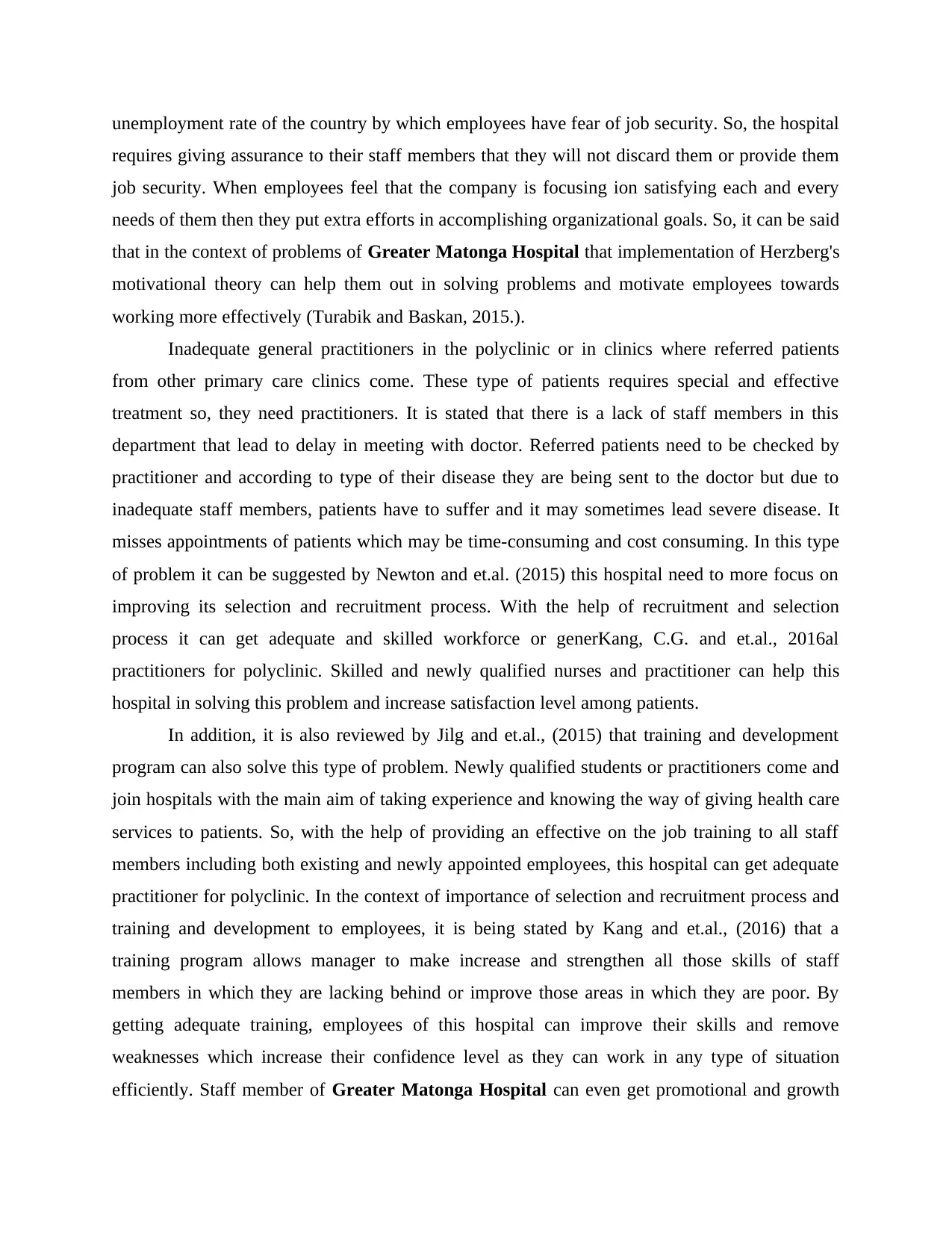
unemployment rate of the country by which employees have fear of job security. So, the hospital
requires giving assurance to their staff members that they will not discard them or provide them
job security. When employees feel that the company is focusing ion satisfying each and every
needs of them then they put extra efforts in accomplishing organizational goals. So, it can be said
that in the context of problems of Greater Matonga Hospital that implementation of Herzberg's
motivational theory can help them out in solving problems and motivate employees towards
working more effectively (Turabik and Baskan, 2015.).
Inadequate general practitioners in the polyclinic or in clinics where referred patients
from other primary care clinics come. These type of patients requires special and effective
treatment so, they need practitioners. It is stated that there is a lack of staff members in this
department that lead to delay in meeting with doctor. Referred patients need to be checked by
practitioner and according to type of their disease they are being sent to the doctor but due to
inadequate staff members, patients have to suffer and it may sometimes lead severe disease. It
misses appointments of patients which may be time-consuming and cost consuming. In this type
of problem it can be suggested by Newton and et.al. (2015) this hospital need to more focus on
improving its selection and recruitment process. With the help of recruitment and selection
process it can get adequate and skilled workforce or generKang, C.G. and et.al., 2016al
practitioners for polyclinic. Skilled and newly qualified nurses and practitioner can help this
hospital in solving this problem and increase satisfaction level among patients.
In addition, it is also reviewed by Jilg and et.al., (2015) that training and development
program can also solve this type of problem. Newly qualified students or practitioners come and
join hospitals with the main aim of taking experience and knowing the way of giving health care
services to patients. So, with the help of providing an effective on the job training to all staff
members including both existing and newly appointed employees, this hospital can get adequate
practitioner for polyclinic. In the context of importance of selection and recruitment process and
training and development to employees, it is being stated by Kang and et.al., (2016) that a
training program allows manager to make increase and strengthen all those skills of staff
members in which they are lacking behind or improve those areas in which they are poor. By
getting adequate training, employees of this hospital can improve their skills and remove
weaknesses which increase their confidence level as they can work in any type of situation
efficiently. Staff member of Greater Matonga Hospital can even get promotional and growth
requires giving assurance to their staff members that they will not discard them or provide them
job security. When employees feel that the company is focusing ion satisfying each and every
needs of them then they put extra efforts in accomplishing organizational goals. So, it can be said
that in the context of problems of Greater Matonga Hospital that implementation of Herzberg's
motivational theory can help them out in solving problems and motivate employees towards
working more effectively (Turabik and Baskan, 2015.).
Inadequate general practitioners in the polyclinic or in clinics where referred patients
from other primary care clinics come. These type of patients requires special and effective
treatment so, they need practitioners. It is stated that there is a lack of staff members in this
department that lead to delay in meeting with doctor. Referred patients need to be checked by
practitioner and according to type of their disease they are being sent to the doctor but due to
inadequate staff members, patients have to suffer and it may sometimes lead severe disease. It
misses appointments of patients which may be time-consuming and cost consuming. In this type
of problem it can be suggested by Newton and et.al. (2015) this hospital need to more focus on
improving its selection and recruitment process. With the help of recruitment and selection
process it can get adequate and skilled workforce or generKang, C.G. and et.al., 2016al
practitioners for polyclinic. Skilled and newly qualified nurses and practitioner can help this
hospital in solving this problem and increase satisfaction level among patients.
In addition, it is also reviewed by Jilg and et.al., (2015) that training and development
program can also solve this type of problem. Newly qualified students or practitioners come and
join hospitals with the main aim of taking experience and knowing the way of giving health care
services to patients. So, with the help of providing an effective on the job training to all staff
members including both existing and newly appointed employees, this hospital can get adequate
practitioner for polyclinic. In the context of importance of selection and recruitment process and
training and development to employees, it is being stated by Kang and et.al., (2016) that a
training program allows manager to make increase and strengthen all those skills of staff
members in which they are lacking behind or improve those areas in which they are poor. By
getting adequate training, employees of this hospital can improve their skills and remove
weaknesses which increase their confidence level as they can work in any type of situation
efficiently. Staff member of Greater Matonga Hospital can even get promotional and growth
Paraphrase This Document
Need a fresh take? Get an instant paraphrase of this document with our AI Paraphraser
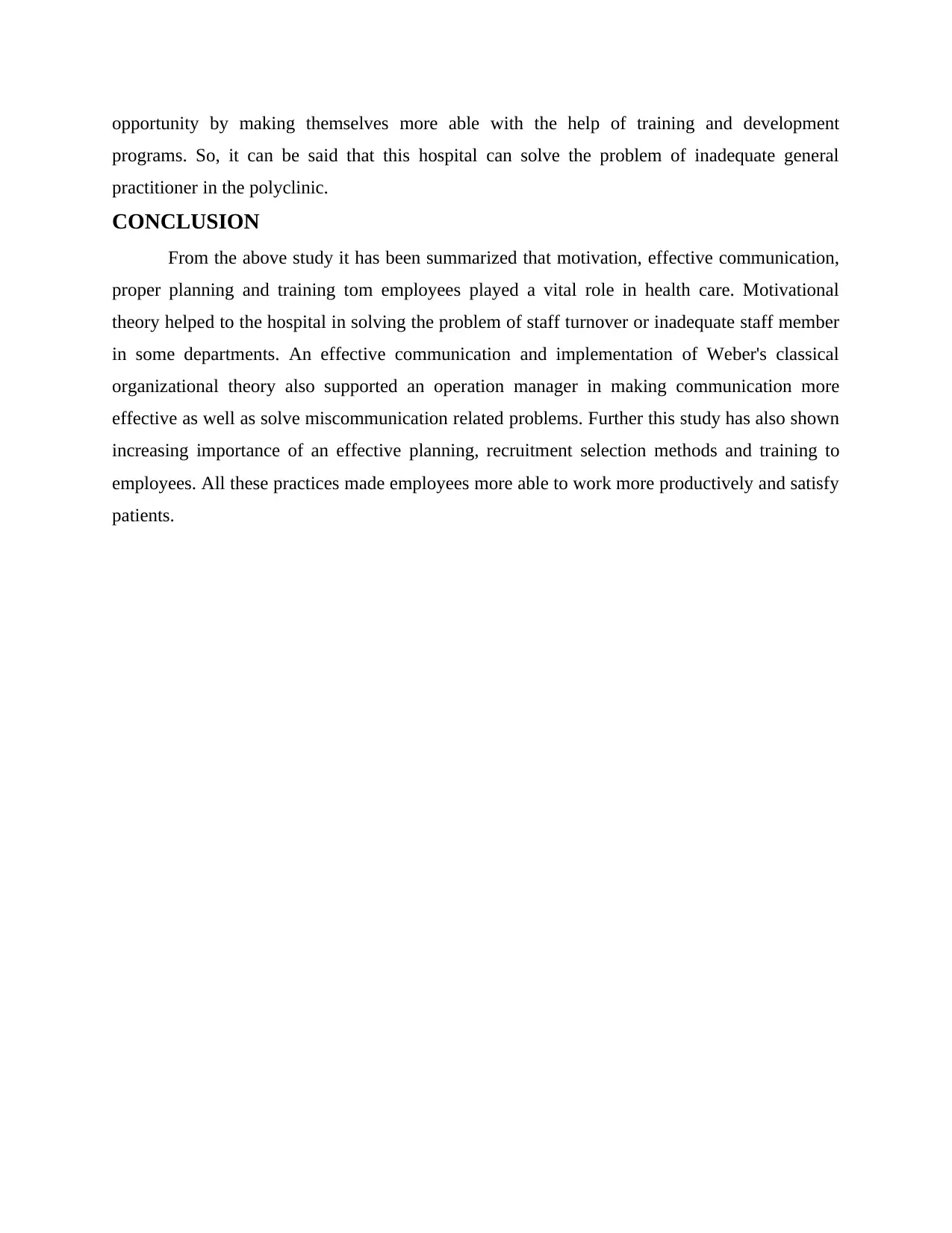
opportunity by making themselves more able with the help of training and development
programs. So, it can be said that this hospital can solve the problem of inadequate general
practitioner in the polyclinic.
CONCLUSION
From the above study it has been summarized that motivation, effective communication,
proper planning and training tom employees played a vital role in health care. Motivational
theory helped to the hospital in solving the problem of staff turnover or inadequate staff member
in some departments. An effective communication and implementation of Weber's classical
organizational theory also supported an operation manager in making communication more
effective as well as solve miscommunication related problems. Further this study has also shown
increasing importance of an effective planning, recruitment selection methods and training to
employees. All these practices made employees more able to work more productively and satisfy
patients.
programs. So, it can be said that this hospital can solve the problem of inadequate general
practitioner in the polyclinic.
CONCLUSION
From the above study it has been summarized that motivation, effective communication,
proper planning and training tom employees played a vital role in health care. Motivational
theory helped to the hospital in solving the problem of staff turnover or inadequate staff member
in some departments. An effective communication and implementation of Weber's classical
organizational theory also supported an operation manager in making communication more
effective as well as solve miscommunication related problems. Further this study has also shown
increasing importance of an effective planning, recruitment selection methods and training to
employees. All these practices made employees more able to work more productively and satisfy
patients.
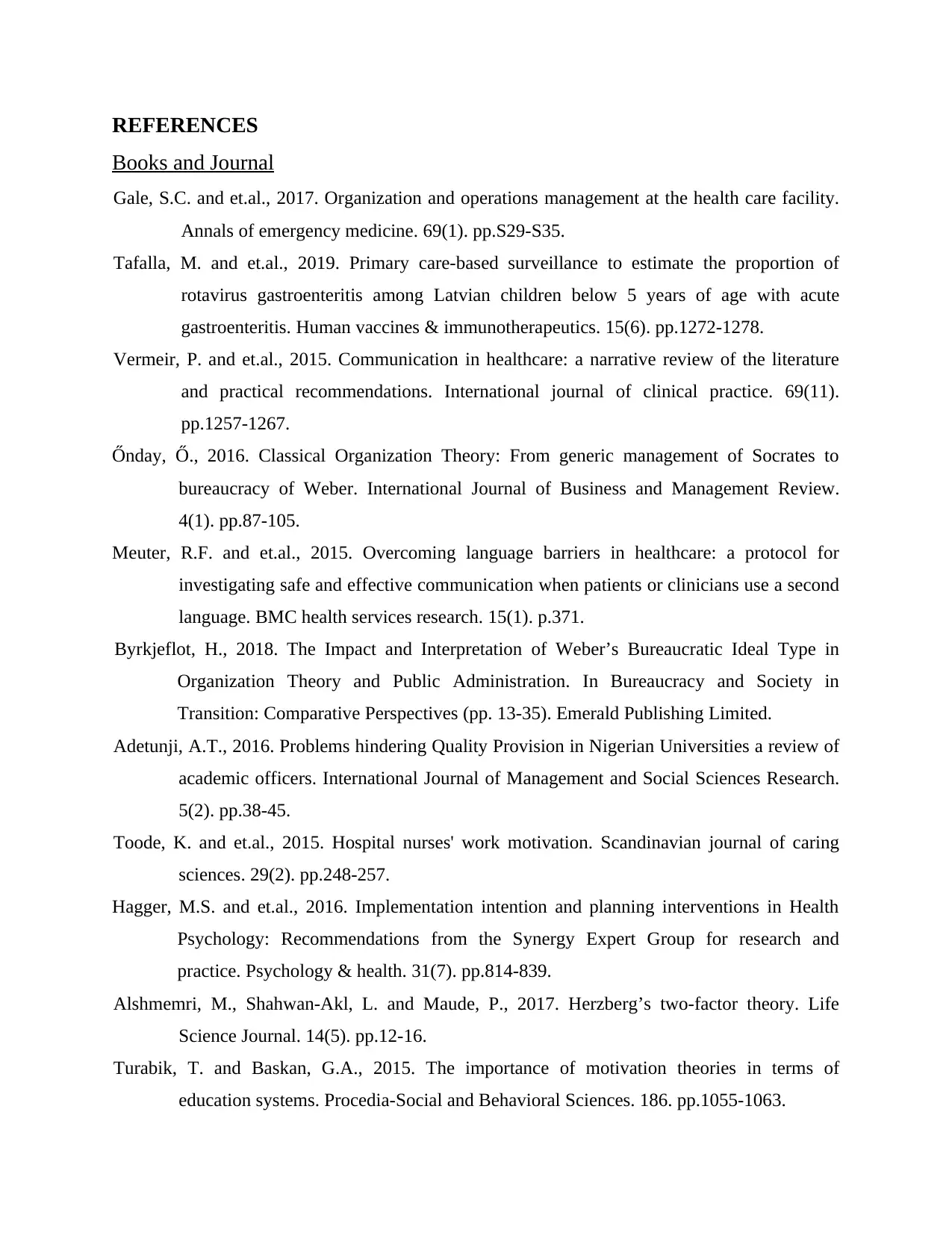
REFERENCES
Books and Journal
Gale, S.C. and et.al., 2017. Organization and operations management at the health care facility.
Annals of emergency medicine. 69(1). pp.S29-S35.
Tafalla, M. and et.al., 2019. Primary care-based surveillance to estimate the proportion of
rotavirus gastroenteritis among Latvian children below 5 years of age with acute
gastroenteritis. Human vaccines & immunotherapeutics. 15(6). pp.1272-1278.
Vermeir, P. and et.al., 2015. Communication in healthcare: a narrative review of the literature
and practical recommendations. International journal of clinical practice. 69(11).
pp.1257-1267.
Őnday, Ő., 2016. Classical Organization Theory: From generic management of Socrates to
bureaucracy of Weber. International Journal of Business and Management Review.
4(1). pp.87-105.
Meuter, R.F. and et.al., 2015. Overcoming language barriers in healthcare: a protocol for
investigating safe and effective communication when patients or clinicians use a second
language. BMC health services research. 15(1). p.371.
Byrkjeflot, H., 2018. The Impact and Interpretation of Weber’s Bureaucratic Ideal Type in
Organization Theory and Public Administration. In Bureaucracy and Society in
Transition: Comparative Perspectives (pp. 13-35). Emerald Publishing Limited.
Adetunji, A.T., 2016. Problems hindering Quality Provision in Nigerian Universities a review of
academic officers. International Journal of Management and Social Sciences Research.
5(2). pp.38-45.
Toode, K. and et.al., 2015. Hospital nurses' work motivation. Scandinavian journal of caring
sciences. 29(2). pp.248-257.
Hagger, M.S. and et.al., 2016. Implementation intention and planning interventions in Health
Psychology: Recommendations from the Synergy Expert Group for research and
practice. Psychology & health. 31(7). pp.814-839.
Alshmemri, M., Shahwan-Akl, L. and Maude, P., 2017. Herzberg’s two-factor theory. Life
Science Journal. 14(5). pp.12-16.
Turabik, T. and Baskan, G.A., 2015. The importance of motivation theories in terms of
education systems. Procedia-Social and Behavioral Sciences. 186. pp.1055-1063.
Books and Journal
Gale, S.C. and et.al., 2017. Organization and operations management at the health care facility.
Annals of emergency medicine. 69(1). pp.S29-S35.
Tafalla, M. and et.al., 2019. Primary care-based surveillance to estimate the proportion of
rotavirus gastroenteritis among Latvian children below 5 years of age with acute
gastroenteritis. Human vaccines & immunotherapeutics. 15(6). pp.1272-1278.
Vermeir, P. and et.al., 2015. Communication in healthcare: a narrative review of the literature
and practical recommendations. International journal of clinical practice. 69(11).
pp.1257-1267.
Őnday, Ő., 2016. Classical Organization Theory: From generic management of Socrates to
bureaucracy of Weber. International Journal of Business and Management Review.
4(1). pp.87-105.
Meuter, R.F. and et.al., 2015. Overcoming language barriers in healthcare: a protocol for
investigating safe and effective communication when patients or clinicians use a second
language. BMC health services research. 15(1). p.371.
Byrkjeflot, H., 2018. The Impact and Interpretation of Weber’s Bureaucratic Ideal Type in
Organization Theory and Public Administration. In Bureaucracy and Society in
Transition: Comparative Perspectives (pp. 13-35). Emerald Publishing Limited.
Adetunji, A.T., 2016. Problems hindering Quality Provision in Nigerian Universities a review of
academic officers. International Journal of Management and Social Sciences Research.
5(2). pp.38-45.
Toode, K. and et.al., 2015. Hospital nurses' work motivation. Scandinavian journal of caring
sciences. 29(2). pp.248-257.
Hagger, M.S. and et.al., 2016. Implementation intention and planning interventions in Health
Psychology: Recommendations from the Synergy Expert Group for research and
practice. Psychology & health. 31(7). pp.814-839.
Alshmemri, M., Shahwan-Akl, L. and Maude, P., 2017. Herzberg’s two-factor theory. Life
Science Journal. 14(5). pp.12-16.
Turabik, T. and Baskan, G.A., 2015. The importance of motivation theories in terms of
education systems. Procedia-Social and Behavioral Sciences. 186. pp.1055-1063.
⊘ This is a preview!⊘
Do you want full access?
Subscribe today to unlock all pages.

Trusted by 1+ million students worldwide
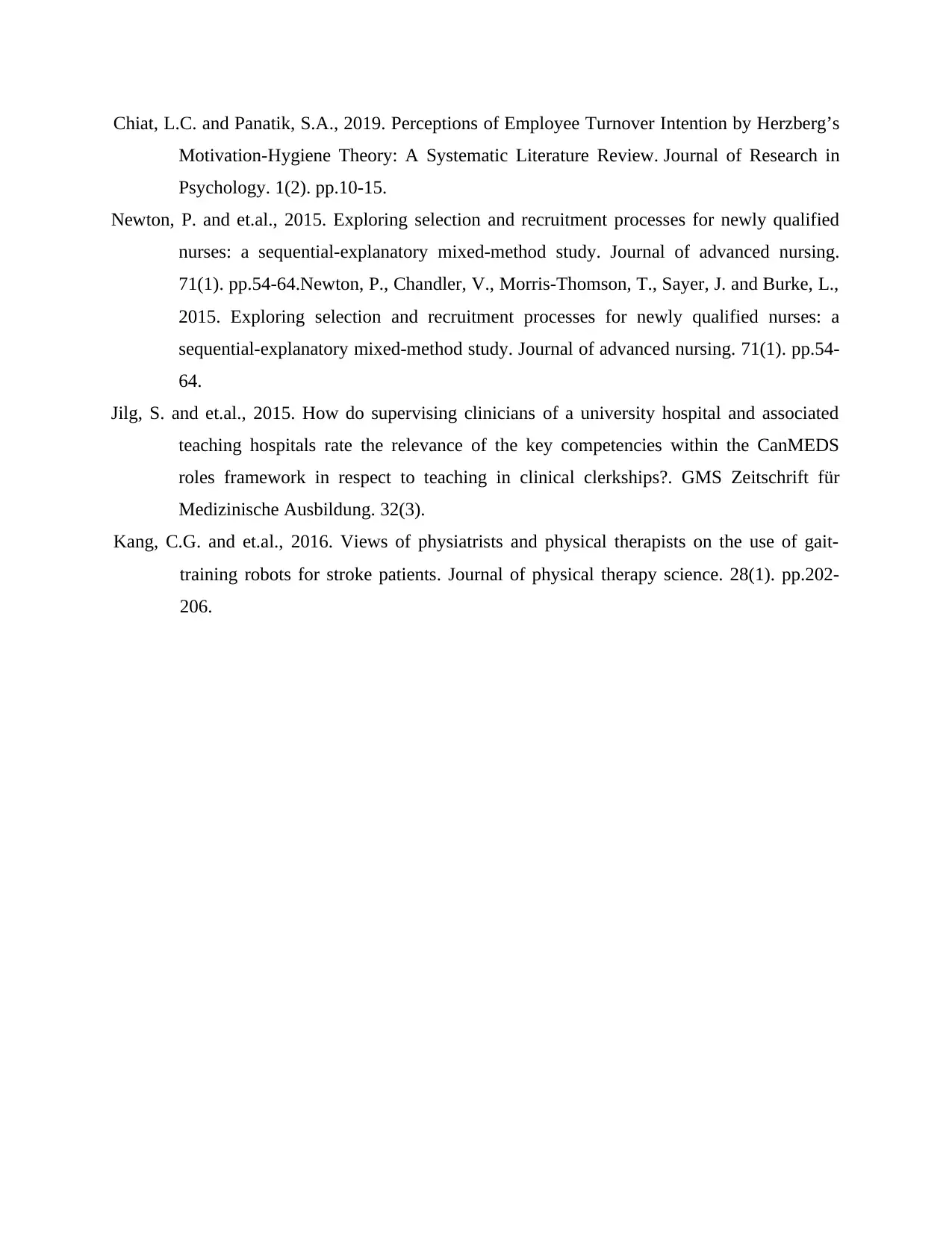
Chiat, L.C. and Panatik, S.A., 2019. Perceptions of Employee Turnover Intention by Herzberg’s
Motivation-Hygiene Theory: A Systematic Literature Review. Journal of Research in
Psychology. 1(2). pp.10-15.
Newton, P. and et.al., 2015. Exploring selection and recruitment processes for newly qualified
nurses: a sequential‐explanatory mixed‐method study. Journal of advanced nursing.
71(1). pp.54-64.Newton, P., Chandler, V., Morris‐Thomson, T., Sayer, J. and Burke, L.,
2015. Exploring selection and recruitment processes for newly qualified nurses: a
sequential‐explanatory mixed‐method study. Journal of advanced nursing. 71(1). pp.54-
64.
Jilg, S. and et.al., 2015. How do supervising clinicians of a university hospital and associated
teaching hospitals rate the relevance of the key competencies within the CanMEDS
roles framework in respect to teaching in clinical clerkships?. GMS Zeitschrift für
Medizinische Ausbildung. 32(3).
Kang, C.G. and et.al., 2016. Views of physiatrists and physical therapists on the use of gait-
training robots for stroke patients. Journal of physical therapy science. 28(1). pp.202-
206.
Motivation-Hygiene Theory: A Systematic Literature Review. Journal of Research in
Psychology. 1(2). pp.10-15.
Newton, P. and et.al., 2015. Exploring selection and recruitment processes for newly qualified
nurses: a sequential‐explanatory mixed‐method study. Journal of advanced nursing.
71(1). pp.54-64.Newton, P., Chandler, V., Morris‐Thomson, T., Sayer, J. and Burke, L.,
2015. Exploring selection and recruitment processes for newly qualified nurses: a
sequential‐explanatory mixed‐method study. Journal of advanced nursing. 71(1). pp.54-
64.
Jilg, S. and et.al., 2015. How do supervising clinicians of a university hospital and associated
teaching hospitals rate the relevance of the key competencies within the CanMEDS
roles framework in respect to teaching in clinical clerkships?. GMS Zeitschrift für
Medizinische Ausbildung. 32(3).
Kang, C.G. and et.al., 2016. Views of physiatrists and physical therapists on the use of gait-
training robots for stroke patients. Journal of physical therapy science. 28(1). pp.202-
206.
1 out of 10
Related Documents
Your All-in-One AI-Powered Toolkit for Academic Success.
+13062052269
info@desklib.com
Available 24*7 on WhatsApp / Email
![[object Object]](/_next/static/media/star-bottom.7253800d.svg)
Unlock your academic potential
Copyright © 2020–2025 A2Z Services. All Rights Reserved. Developed and managed by ZUCOL.





